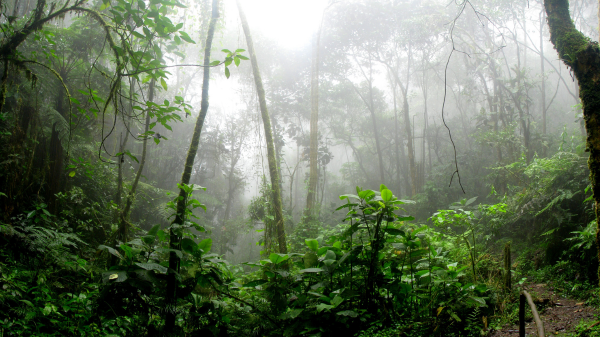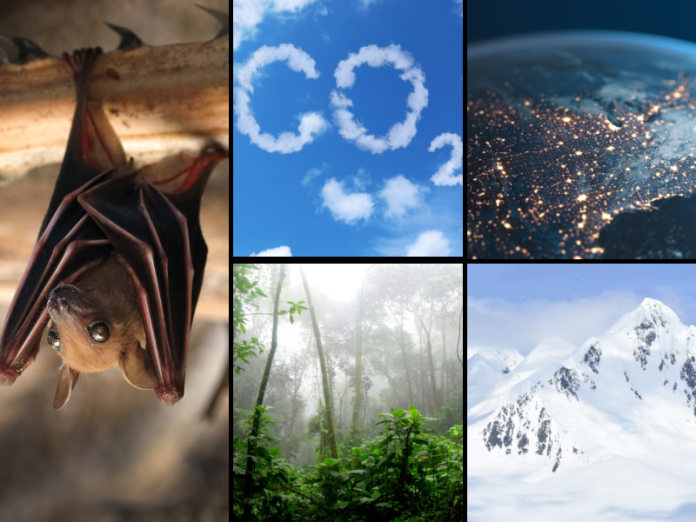YOU SHOULD SUBSCRIBE TO CLIMATE CHANGE WEEKLY.
IN THIS ISSUE:
- Evidence Mounts that Green Tech Is Wiping Out Species
- Video of the Week: The Cold, not the Heat, Is the Big Killer
- Temperature Changes Drive CO2, Not the Other Way Around
- Podcast of the Week: Kamala Harris Is Even More Radical on Climate than Joe Biden
- Humans Are Adaptive, There Is No Specific Niche for Human Flourishing
- Trees Remove Methane as well as CO2
- Antarctica Broke Cold Temperature Records in 2023
- Climate Comedy
- Recommended Sites
Watch ALL the Presentations by the ALL-STARS of Climate Realism at the Archive of Heartland’s 15 Climate Conferences
Evidence Mounts that Green Tech Is Wiping Out Species

I and other Heartland Institute scholars have written before about the bird, bat, and marine mammals that industrial wind is killing around the world. The Heartland Institute has also written concerning industrial solar’s threat to desert species, including the endangered desert tortoise, and also to birds.
Those are species directly killed by the technologies as they function. New research indicates the indirect harmful impact of “green energy” on animal species may be even greater than the direct deaths from the technologies when operating.
A study published in the journal Current Biology by a team of researchers from the University of Sheffield and Cambridge University finds the world’s pursuit of net zero carbon dioxide emissions, in large part through the expansion of industrial wind, solar, and battery power (the latter for transportation and backup electric power), is threatening thousands of species indirectly, through the mining and infrastructure required to construct, install, and make green technologies operational.
According to the study, mineral mining and energy infrastructure endangers 4,642 species of vertebrates, and the shift to renewable energy technologies, which are very critical-mineral dependent and produced in countries with little if any environmental safeguards, has massively exacerbated the problem. Sand mining for raw material for solar panels is also a problem. Describing the research, an article in Newsbreak states:
This is the most complete global assessment of the threat to biodiversity from mineral extraction ever undertaken. …
Mining activities coincide with some of the most valuable biodiversity hotspots in the world, which harbor a wide variety of species and unique habitats that are not found anywhere else on Earth.
The transition to clean energy poses a significant threat to species due to mining essential materials like lithium and cobalt, which are key components of solar panels, wind turbines, and electric cars.
The threat to nature isn’t limited to the physical locations of the mines. For example, species living at great distances can also be impacted by polluted watercourses or deforestation for new access roads and infrastructure.
With 2,053 species negatively impacted or endangered by mining, refining, and energy infrastructure development, fish and shellfish species are at especially high risk from mining, with its associated runoff, sedimentation, and pollution from nearby mines or water pollution produced during refining to separate the critical metals and minerals from massive amounts of mined dirt and rocks, called overburden. Reptiles, amphibians, birds, and mammals fill out the rest of the list of the species endangered by energy, especially green energy, associated development.
“We simply won’t be able to deliver the clean energy we need to reduce our climate impact without mining for the materials we need, and that creates a problem because we’re mining in locations that often have very high levels of biodiversity,” David Edwards, Ph.D., a co-author of the study, told Newsbreak. “So many species, particularly fish, are being put at risk through the pollution caused by mining.”
Global demand for critical metals and minerals is growing dramatically, due to the forced demand by government for green energy in pursuit of CO2 reduction. Studies show that green energy technologies rely on these metals and minerals much more intensively than traditional energy sources and modes of transportation. For example, one study by the International Energy Agency reported that, “[s]ince 2010 the average amount of minerals needed for a new unit of power generation capacity has increased by 50 percent as the share of renewables in new investment has risen.”
The impact of mining on species can be far from the actual site of mines and refining facilities. For example, forests are commonly cleared for roads, and animals are depleted through black market hunting (both for markets and for food for the workers), as areas in formerly remote locations are made more easily accessible. On this point, the new study says:
The land area impacted by indirect threats from mineral extraction could dwarf the area impacted by the direct global footprint of terrestrial mines. Mines have a relatively small direct global footprint (101,583 km2), yet mining can increase deforestation up to 70 km from mining sites in the Amazon, and pollution from metal mineral mines affects 479,200 km of rivers and 164,000 km2 of flood plains globally.
It appears the authors did not examine the plant and insect life possibly harmed by the green energy supply chain but, based on the scale of the land disruption, it is also likely to be a large number.
This study provides more evidence that green energy isn’t green or clean if by that you mean having a minimal, negative environmental impact.
Sources: Newsbreak; Current Biology; International Energy Agency
NEW: Get Climate at a Glance on your mobile device!
Video of the Week
Extreme heat is often identified as the most significant cause of premature death attributed to climate change. But The Heartland Institute’s Linnea Lueken explains that peer-reviewed research, informed by real-world data, clearly shows deaths associated with cold temperatures significantly outnumber heat related deaths by almost 10 to 1.
Temperature Changes Drive CO2, Not the Other Way Around

New research from Demetris Koutsoyiannis, Ph.D., professor emeritus for Hydrology and Analysis of Hydrosystems in the National Technical University of Athens, published in the journal Mathematical Biosciences and Engineering, suggests that CO2 rather than driving climate change, is a lagging indicator, with changes in CO2 levels being a consequence of or a response to a changing climate.
As described on No Tricks Zone, Koutsoyiannis produced a large-scale, significant analysis detailing the sequence of “CO2 variations versus temperature variations since the 1950s, over the last 2,000 years (the Common Era), and throughout the last 541 million years.”
Koutsoyiannis examined multiple datasets for recent CO2 and temperatures measurements covering the last 70 years, and “[s]everal proxy series, extending over the Phanerozoic or parts of it, gradually improving in accuracy and temporal resolution up to the modern period of accurate records, are compiled, paired, and analyzed.”
Koutsoyiannis used a stochastic methodology to determine whether the relationship between the two phenomena, temperature and CO2, was random or robust and causal. After comparing the data, Koutsoyiannis concluded in his paper (actually part of a series of peer-reviewed papers examining the topic or related topics which he authored or co-authored over the past couple of years):
The extensive analyses made converge to the single inference that change in temperature leads, and that in carbon dioxide concentration lags. This conclusion is valid for both proxy and instrumental data in all time scales and time spans. … The time lags found depend on the time span and time scale and are of the same order of magnitude as the latter. These results contradict the conventional wisdom, according to which the temperature rise is caused by [CO2] increase.
Sources: Mathematical Biosciences and Engineering; No Tricks Zone
Heartland’s Must-read Climate Sites



Podcast of the Week
With Joe Biden handing off the presidency to “a new generation” in Kamala Harris, her record and public statements shows she is even more radical on environment and energy policies than her old boss. For instance, Harris thoroughly endorsed every bit of the radical “Green New Deal,” she pledged to ban all fracking in the United States, she has fully embraced the “Net Zero by 2030” agenda, and has called for changing the American diet by restricting (or even banning) the production of beef.
Subscribe to the Environment & Climate News podcast on Apple Podcasts, iHeart, Spotify or wherever you get your podcasts. And be sure to leave a positive review!
Humans Are Adaptive, There Is No Specific Niche for Human Flourishing

While organizations such as the Intergovernmental Panel on Climate Change, the World Health Organization, the National Oceanic and Atmospheric Administration, and the mainstream media in general have been pushing the narrative that:
humanity resides within a “human climate niche” (HCN) defined by temperature … [t]he basics of the idea are compelling and clear: anthropogenic warming may cast millions, or even billions, outside of the boundaries of normal human habitation, with abundant negative consequences for human well-being, mortality, and levels of international migration.
Those are the words of a team of researchers from universities in the United Kingdom and France, who published a study in the journal One Earth, which ultimately refuted the “notion that there exists a single, ideal climatic state for humans.”
They found that the claim lacks merit, being politically driven and “analytically flawed.” The theory fails to account for or acknowledge the wide variety of ecosystems and environmental conditions that human societies have adapted to and flourished in over multiple millennia, sometimes by modifying the environment itself to their benefit.
In short, no ideal, deterministic narrow climate niche or set of conditions has been identified as being necessary for human societies to thrive.
The HCN claim is flawed in theory and debunked in practice. Theoretically, “the HCN idea is lacking any conceptual foundation from within ecology and is out of line with modern understandings of ecological niches.”
And as a matter of history, billions of people have long lived in, and human societies thrived, outside of the temperature conditions the HCN theory claims deterministically sets boundaries on human societies’ ability to thrive. Humans have lived through warmer times globally and cooler times globally, and regionally, they have long existed in extreme climates ranging from the frigid Arctic to the intense heat of the Sahara Desert, and the tropical heat and humidity of the Amazonian and African jungles.
Humans have proved adaptable to a wide range of environments, often developing and using technological innovations and changing socio-economic institutions to alter local environments for their comfort and well-being.
Concerning this point, the researchers write:
There is no good reason why human populations cannot reside or concentrate outside of the temperature range, threshold, or ideal distribution curve suggested in the aforementioned HCN studies—indeed, many millions (and, in the case of the 11°C–15°C MAT [mean average temperature] range, billions) already do so. That population growth in regions with an MAT of >29°C is currently above (and is projected to continue being above) the global average is telling in this regard—and is certainly not what one would expect if the HCN were a “fundamental constraint on human populations,” as is claimed.
Looking at both the theory and the facts, they conclude, “[t]here is, in our assessment, no universal, timeless, climatically determined envelope within which, and only within which, humans can live and thrive—and claims that there does exist such an envelope are dangerous.”
Sources: Irrational Fear; One Earth
Trees Remove Methane as well as CO2

Methane is a small greenhouse gas as a percentage of the atmosphere, but a powerful one relative to the more dominant water vapor and carbon dioxide.
It has long been recognized that older, climax forests, or unmanaged forests and heavily treed wetlands, are net emitters of methane, both from the soil and from the rotting vegetation.
But recent research published in the journal Nature indicates trees are also a sink for methane, and in fact store significant amounts of methane in woody surfaces that is unaccounted for in climate models.
The new research calculates the woody surface of trees, and examines tree bark microbes captured in cores, finding through chemical analysis that they absorb significant amounts of methane, increasing the supposed “climate benefit” of trees—the greenhouse gas removing benefit above what they do by removing carbon dioxide during photosynthesis—by about 10 percent.
In particular, they write, “that methane uptake on woody surfaces, in particular at and above about 2 m above the forest floor, can dominate the net ecosystem contribution of trees, resulting in a net tree methane sink.”
Commenting on the importance of the findings to climate policy, SciTechDaily says “[t]his finding underscores the importance of trees in mitigating climate change and supports tree planting and forest conservation as key strategies in global methane reduction efforts.”
“The main ways in which we consider the contribution of trees to the environment is through absorbing carbon dioxide through photosynthesis and storing it as carbon,” the study’s lead author, Vincent Gauci, Ph.D., of the University of Birmingham, told SciTechDaily. “These results, however, show a remarkable new way in which trees provide a vital climate service.
“The Global Methane Pledge, launched in 2021 at the COP26 climate change summit aims to cut methane emissions by 30 percent by the end of the decade,” Gauci continued. “Our results suggest that planting more trees, and reducing deforestation surely must be important parts of any approach towards this goal.”
Sources: Nature; SciTechDaily
Antarctica Broke Cold Temperature Records in 2023

New research published in the journal Advances in Atmospheric Sciences shows that Antarctica’s normally extremely cold temperatures were colder still in 2023, with several manned and automatic weather stations across the continent recording new cold temperature records.
“Record cold temperatures were observed in our Automatic Weather Stations (AWS) network as well as other locations around the region,” Matthew A. Lazzara of the Antarctic Meteorological Research and Data Center at the University of Wisconsin-Madison, told Phy.org. “These phases were marked by new record low temperatures recorded at both staffed and automatic weather stations, spanning East Antarctica, the Ross Ice Shelf, and West Antarctica to the Antarctic Peninsula.”
For example, the Kunlun Station recorded its lowest temperature ever observed at -79.4°C, which was about 5°C lower than the monthly average,
Record-breaking cold spells came in four distinct periods or phases during the Southern Hemisphere’s winter of 2023. Phy.org reports conditions were so harsh, with temperatures plummeting below -50°C for extended periods of time, that “essential flight operations to key research stations were severely disrupted. These temperatures risked hydraulic failure and fuel gelling in aircraft, rendering safe flights impossible.
“‘These extreme cold events were unprecedented and had significant operational impacts,’ said David E. Mikolajczyk, the corresponding author of the study [reported Phy.org]. ‘Understanding these conditions helps us better prepare for future challenges in Antarctic logistics.’”
Sources: Phy.org; Advances in Atmospheric Sciences




























